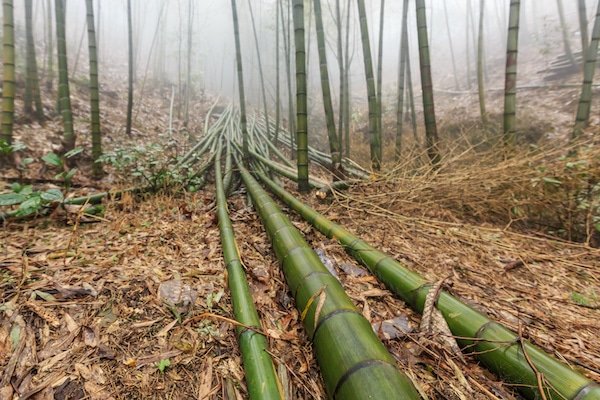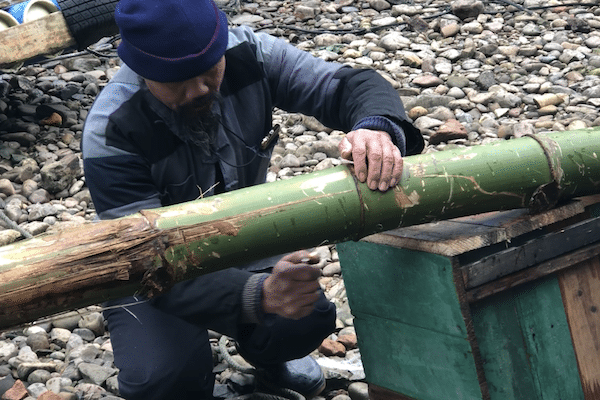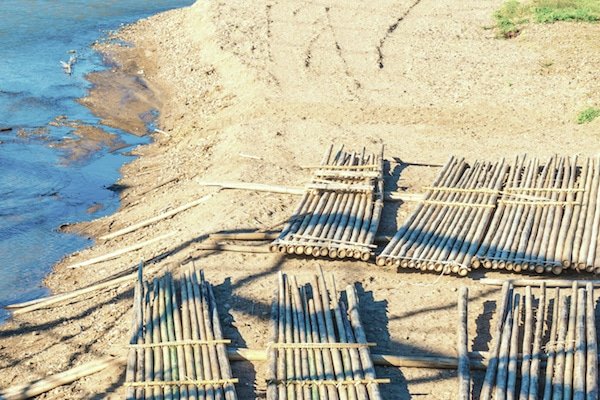How to Build a Bamboo Raft
Totally handcrafted throughout complicated 5 steps
Bamboo rafts are used by the locals as a transportation means along the Li River. It dates back to 1,000 years ago and now people are still handcrafting rafts in old fashion.
About Bamboo Rafts on the Li River
- Totally handcrafted and only made to order, no massive produce or factory, only private workshop.
- Moso bamboo of over 3 years old is the choice of material, which is found in mountainous areas.
- Light in draught and more buoyant than metal boats, bamboo rafts acclimatize better to the narrow and shallow rivers of Yangshuo.
- Most bamboo rafts are 7 meters / 23 feet at length and 4 meters / 13 feet at width, lighter in weight and easier to control by manpower.
5 Steps to Build a Bamboo Raft
We have spent a couple of weekends with a raft-making master in Yangshuo and he showed us how it's done: 5 steps in 2-day work.
Step-01: Selecting the Right Material
For a raft that can take up to 4 passengers, it is usually made of 8 to 10 bamboo branches. Moso bamboo of 3 years old are cut and shipped from the mountainous areas near Guilin. No telling how old the bamboos are, it can only be judged by the color of the skin; the lighter the stronger.
Spring is the best time to select good bamboos and those that have survied the winter make the cut. Craftsmen will spare 2 to 3 branches in case of damage during the building.
Step-03: Bending
Bamboo branch is placed on one platform with two ends tucked down by heavy objects before the roasting starts. Fire, usually a torch, goes under the first 2 to 3 knots from each end. Nowadays craftsmen use disel torch as it's easier to control.
When one side is done, the branch will be rolled over to the other side for short roasting just to make the other side soft, or else it will crrack and break. Each end will be bent for a slight 30 degree. This takes about 3 hours.
Step-05: Painting and Drying
After everything is done, now you have a bamboo raft to sail. However, the new-made raft can be very vulnerable as the bamboo branches were cut fresh and water inside the fibers can easily corrupt the entire raft. Thus the craftsmen will apply some oil on the exterior.
Tong oil used to be the major material but now people turn to varnish due to tong oil's deficiency and high price. After painting, they will be left under the sun to dry. It takes half to one day.
Step-02: Peeling and Polishing
A sickle is used to peel of the green skin of the bamboo branches before a smaller knife comes in to polish the roughness. Both start from the bottom - which is thinner than the top, and go all the way to the top, which makes sure the entire branch even in thickness.
The knots are the most critical part as you would want them to be even and smooth without breaking them by peeling or polishing too hard.
Peeling and polishing take about 5 to 7 hours.
Step-04: Nailing
After all the branches are peeled, polished and bent, they will be laid one by one parallelly before staking together. To make the work easier, some craftsmen will drill holes near the first 2 or 3 knots.Two thick wood stakes or metal pipes will be staked through the holes.
The head of the raft will be nailed very tight, yet the tail will be much loosen, which ensures the rafts make turns easily in riffles or shallow waters. This is another 2-hour work.
Maintainence
A bamboo raft costs around 1,000 to 1,5000RMB. A new raft can last merely one year without any maintainence. Regular repainting and sundry extend its service life.
Bamboo rafts in Yangshuo are now only used by the fishermen. For rafting trips, only motor ones, which are made of plastic pipes. Surperising enough, these plastic-made rafts are 3 to 5 times more expensive than a hand-made bamboo rafts. Its weight and stability work better for safety.
Watch the video of the craftsman peeling and polishing the bamboo branch.
Some of our local friends in Yangshuo are still practing this craft. Talking to them gets us better understanding of how life along the Li River has changed over the decades. We will be happy to introduce you to them if you're interested. Want to include this special experience to your Guilin trip? Talk to our team and find out more!







